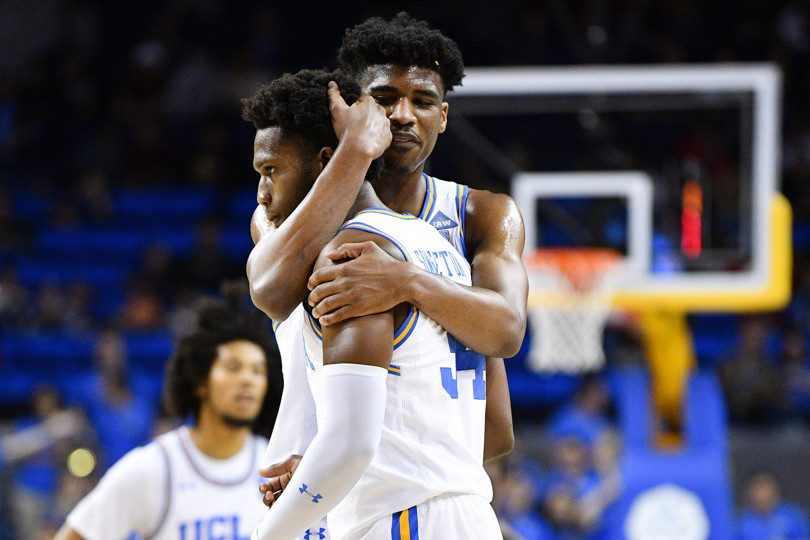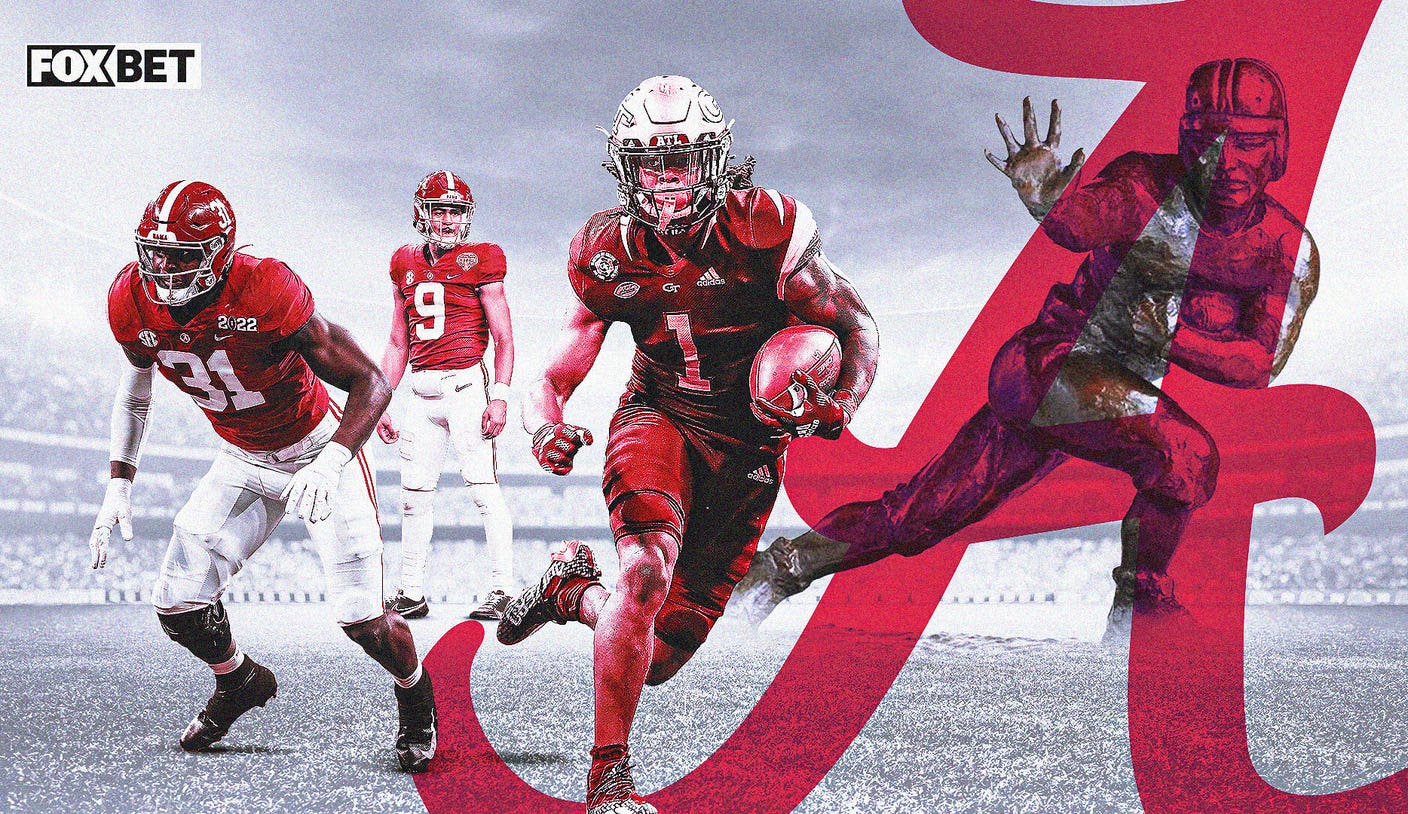UCLA is a Wildcard at the NCAA Tournament Bubble
February 28, 2020 – by Jason Lisk

UCLA is going to be in the middle of the bubble debate for 2020 (Photo by Brian Rothmuller/Icon Sportswire)
UCLA came back and won against Arizona State on Thursday with a last-second shot. That moved the Bruins into a first-place tie in the Pac-12 with only two games remaining. On Saturday, they followed it up with a home win over Arizona.
UCLA, though, isn’t highly thought of as a NCAA Tournament team. In the Bracket Matrix, only two of 94 brackets had them in the field as of Friday following the Arizona State win. Three days later, just over half of the brackets had moved them into the field.
The Bruins started their season only 7-6 in the non-conference in head coach Mick Cronin’s first year in Westwood, and had no quality wins entering conference play. They also started Pac-12 play 1-3 to drop to 8-9 overall by mid-January. Since that point, though, they have been hot, winning 11 of 13. That includes a sweep of Colorado and Arizona, and the victory over Arizona State.
So in this post, we’ll review UCLA’s case based on recent committee decisions.
[For full breakdown of the 2020 NCAA Tournament Bubble, click here]
UCLA’s Profile
Content:
ToggleUCLA currently ranks 76th in the NET, and still aren’t highly rated in predictive ranking systems. They sit at 77th in our predictive rankings. That’s a jump from where they were in mid-January, at 109th.
However, what they do have is “Quadrant 1” wins. UCLA is currently 6-6 in Quadrant 1, including top tier road wins at Colorado and Arizona. They are also 3-3 in Quadrant 2 games, for a combined record of 9-9 in those quads.
Their remaining games will likely all be Quadrant 1 (or at least Quadrant 2) contests. They close against USC in the regular season. They would then likely face a potential Quadrant 1 team in the Pac-12 tournament bracket.
It’s an unusual profile, especially given their start to the season, but it’s not completely unprecedented. Let’s take a look at recent history to see some similar decisions.
Comparable Teams to 2020 UCLA
The list of comparable teams was put together by finding all teams since 2011 that met the following criteria:
They were ranked No. 60 or worse in the RPI or NET as of Selection Sunday; andThey had at least five Quadrant 1 (or Top 50, before 2018) and eight total Quadrant 1 & 2 (or Top 100) wins as of Selection Sunday.
Using the projected results for UCLA’s remaining games, the list is ordered by teams most similar in Quad 1, combined Quad 1 & 2, overall record, and NET/RPI ranking.
Here are the teams:
| Team | Year | NET/RPI Rank | Quad 1 Wins | Quad 1 Losses | Quad 1+2 Wins | Quad 1+2 Losses | Outcome |
|---|---|---|---|---|---|---|---|
| Colorado | 2011 | 65 | 6 | 7 | 8 | 10 | NIT #1 Seed |
| Syracuse | 2017 | 84 | 6 | 8 | 8 | 9 | NIT #1 Seed |
| St. John’s | 2019 | 73 | 5 | 7 | 10 | 10 | NCAA #11 Seed (Dayton) |
| Syracuse | 2016 | 72 | 5 | 6 | 8 | 10 | NCAA #10 Seed |
| Georgetown | 2019 | 82 | 5 | 6 | 11 | 11 | NIT #3 Seed |
| Marquette | 2017 | 61 | 7 | 7 | 9 | 10 | NCAA #10 Seed |
| LSU | 2018 | 94 | 6 | 5 | 9 | 12 | NIT #3 Seed |
| Georgia | 2018 | 79 | 5 | 10 | 10 | 13 | Declined NIT invite |
| Virginia Tech | 2018 | 61 | 5 | 7 | 8 | 10 | NCAA #8 Seed |
| NC State | 2018 | 64 | 5 | 7 | 8 | 9 | NCAA #9 Seed |
| Minnesota | 2019 | 61 | 5 | 10 | 12 | 12 | NCAA #10 Seed |
| USC | 2011 | 67 | 5 | 5 | 8 | 8 | NCAA #11 Seed (Dayton) |
| Oklahoma State | 2018 | 88 | 5 | 12 | 8 | 14 | NIT #2 Seed |
Looking over that list, UCLA appears right on the bubble’s edge, capable of either just getting in or being made a NIT #1 Seed.
UCLA is a True Bubble Team and Wildcard heading to Selection Sunday
That list contains teams that were right on the cutline, and includes some notable and controversial (read: a lot of bracketologists had them out) choices.
St. John’s was not a clear choice a year ago as one of the final teams in the at-large field. 66% of final brackets on the Bracket Matrix had them in the field.Syracuse back in 2016 created plenty of discussion, and the committee put them in (and then they went to the Final Four). Only 38% of final brackets in the Bracket Matrix had them in, and yet they got a 10 Seed.A year later, Syracuse was again a lightning rod of discussion, but just missed selection as five losses outside the Top 100 and an RPI over 80 put them just out.USC in 2011 was a surprise choice, and they were the first VCU victim in the very first year of the First Four games for at-large teams.
In fact, the three lowest teams by RPI/NET ranking since 2011 to get at-large bids show up on UCLA’s list of similar teams.
LSU, Georgia, and Oklahoma State arguably represent UCLA’s worst case scenario now. All were at least three games under .500 against the top two Quadrants, and had worse NET/RPI rankings than UCLA does now. UCLA will not get to three games under .500 against the top two quads, and can do no worse than 9-11.
If UCLA finishes the year, say, 19-13 by closing with a loss to USC then a loss in the Pac-12 tournament, they will have six Quad 1 wins and be right in line with these past bubble teams. Who knows which way the wind will blow with this particular committee? But based on recent history, UCLA will be one of the most discussed and debated teams as we move toward Selection Sunday.
If you liked this post, please share it. Thank you! Twitter Facebook
NFL Football Pool Picks NFL Survivor Pool Picks NCAA Bracket Picks College Bowl Pool Picks College Football Pool Picks NFL Picks NBA Picks MLB Picks College Football Picks College Basketball Picks NFL Predictions NBA Predictions MLB Predictions College Football Predictions College Basketball Predictions NFL Spread Picks NBA Spread Picks MLB Spread Picks College Football Spread Picks College Basketball Spread Picks NFL Rankings NBA Rankings MLB Rankings College Football Rankings College Basketball Rankings NFL Stats NBA Stats MLB Stats College Football Stats College Basketball Stats NFL Odds NBA Odds MLB Odds College Football Odds College Basketball Odds A product ofTeamRankings BlogAboutTeamJobsContact
© 2005-2024 Team Rankings, LLC. All Rights Reserved. Statistical data provided by Gracenote.
TeamRankings.com is not affiliated with the National Collegiate Athletic Association (NCAA®) or March Madness Athletic Association, neither of which has supplied, reviewed, approved or endorsed the material on this site. TeamRankings.com is solely responsible for this site but makes no guarantee about the accuracy or completeness of the information herein.
Terms of ServicePrivacy Policy



